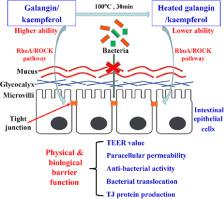The Journal of Nutritional Biochemistry ( IF 4.8 ) Pub Date : 2020-10-02 , DOI: 10.1016/j.jnutbio.2020.108517 Jing Fan 1 , Xin-Huai Zhao 2 , Tie-Jing Li 3

|
Flavonols are bioactive substances in plant foods. In this study, two flavonols galangin and kaempferol were heated at 100°C for 30 min prior to assessing their effects on barrier function of rat intestinal epithelial (IEC-6) cells. Both heated and unheated flavonols (2.5−20 µmol/L dosages) were nontoxic to the cells up to 48 h post-treatment, and could promote cell viability values to 102.2−141.2% of control. By treatment with 5 µmol/L flavonols for 24 and 48 h, the treated cells time-dependently showed better improved physical and biological barrier functions than the control cells without any flavonol treatment, including higher transepithelial electrical resistance and antibacterial effect but reduced paracellular permeability and bacterial translocation. The results from real-time PCR and western-blot assays indicated that the cells treated with heated and unheated flavonols of 5 µmol/L dosage had up-regulated mRNA (1.13−1.81 folds) and protein (1.15−5.11 folds) expression for zonula occluden-1, occludin, and claudin-1 that are vital to the tight junctions of the cells. Moreover, protein expression of RhoA and ROCK were down-regulated into 0.41−0.98 and 0.40−0.92 folds, respectively, demonstrating a Rho inactivation that led to enhanced cell barrier integrity via the RhoA/ROCK pathway. Overall, galangin was more active than kaempferol to perform three biofunctions like improving cell barrier function, up-regulating tight junctions protein expression, and down-regulating RhoA/ROCK expression. Moreover, the heated flavonols were less effective than the unheated counterparts to perform these biofunctions. It is concluded that this heat treatment of galangin and kaempferol could inhibit their benefits to improve barrier function of IEC-6 cells.
中文翻译:

高良姜素和山奈酚的热处理抑制了它们改善大鼠肠上皮细胞屏障功能的益处
黄酮醇是植物性食物中的生物活性物质。在这项研究中,两种黄酮醇高良姜素和山奈酚在 100°C 下加热 30 分钟,然后评估它们对大鼠肠上皮 (IEC-6) 细胞屏障功能的影响。加热和未加热的黄酮醇(2.5-20 µmol/L 剂量)在处理后 48 小时内对细胞无毒,并且可以将细胞活力值提高到对照的 102.2-141.2%。5 μmol/L 黄酮醇处理 24 和 48 小时后,处理后的细胞比未进行任何黄酮醇处理的对照细胞显示出更好的物理和生物屏障功能改善,包括更高的跨上皮电阻和抗菌作用,但降低了细胞旁通透性和细菌移位。实时 PCR 和蛋白质印迹分析的结果表明,用 5 μmol/L 剂量的加热和未加热黄酮醇处理的细胞具有上调小带的 mRNA(1.13-1.81 倍)和蛋白质(1.15-5.11 倍)表达occluden-1、occludin 和 claudin-1,它们对细胞的紧密连接至关重要。此外,RhoA 和 ROCK 的蛋白质表达分别下调至 0.41-0.98 和 0.40-0.92 倍,表明 Rho 失活导致细胞屏障完整性增强通过RhoA/ROCK 途径。总体而言,高良姜素比山奈酚更活跃,可以执行三种生物功能,如改善细胞屏障功能、上调紧密连接蛋白表达和下调 RhoA/ROCK 表达。此外,加热的黄酮醇在执行这些生物功能方面不如未加热的对应物有效。结论是高良姜素和山奈酚的这种热处理会抑制它们改善IEC-6细胞屏障功能的益处。









































 京公网安备 11010802027423号
京公网安备 11010802027423号